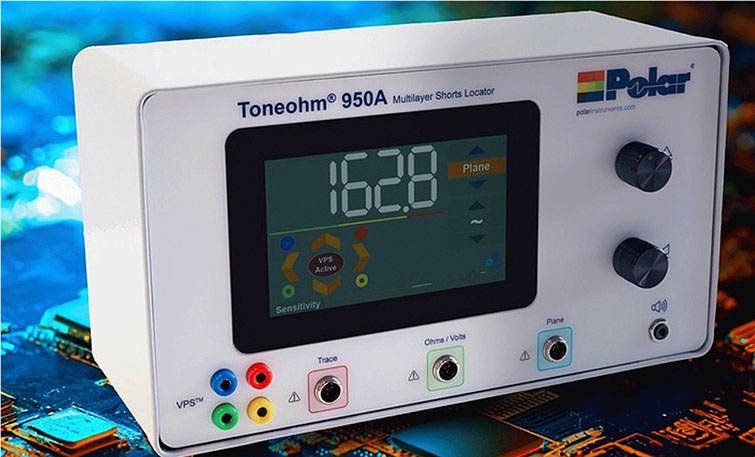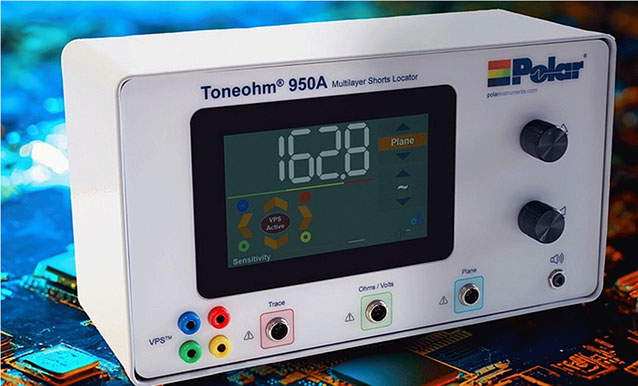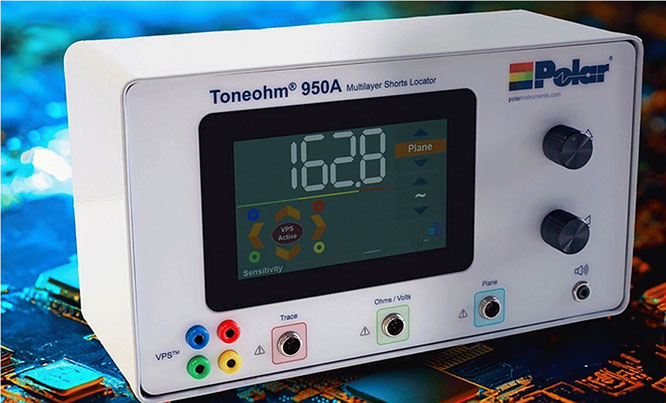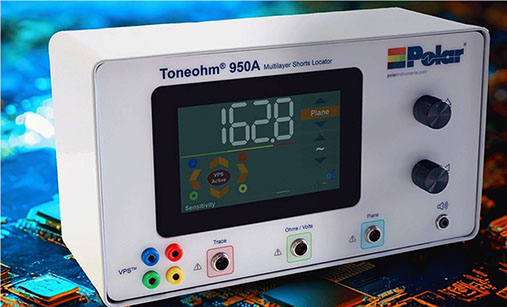PCB stackup, signal integrity and controlled impedance Software and test systems for PCB assembly and repair
Toneohm 950A
multi-layer short circuit locator
Manufacturers and assemblers of electronic printed circuit boards are constantly striving to:
- Increase production throughput
- Minimize rejects and scrap
- Reduce rework time and cost
- Maintain and improve quality






locate short circuits on bare and loaded PCBs with high precision
locate short circuits on bare and loaded PCBs with high precision
Polar Toneohms are ideal tools for the electronics production environment. Able to locate shorts quickly and accurately on both bare and loaded PCBs, they provide a very cost-effective means of minimizing repair and rework of faulty PCBs that have been identified by pass/fail testing on an ATE system.
Manufacturers and assemblers of electronic printed circuit boards are constantly striving to:
- Increase production throughput
- Minimize rejects and scrap
- Reduce rework time and cost
- Maintain and improve quality
A significant percentage of electronics manufacturing and in-service defects are caused by PCB short-circuits or faulty devices loading the circuit. Automatic PCB test equipment or conventional fault detection techniques can be used to diagnose the presence of shorts, but not their physical location.
In recent years, shorts location has become more difficult due to the introduction of:
- Multilayer boards
- Bus-structured circuits
- Densely-packed components
- Surface-mount
- Fine-line tracksPower and earth planes
The Toneohm 950A represents the definitive solution to all these problems. Employing innovative Vector Plane Stimulus (VPS™) techniques, the instrument provides fast and accurate guidance to the origin of PCB shorts. From an operator's point of view, nothing could be easier to use - you just follow the arrows on the instrument's front panel!
Why do you need the Toneohm 950A?
PCBs are becoming more complex and valuable in terms of both cost and the requirements for 100% yield in the production process. Witness the very rapid growth in multilayer fabrication techniques, surface-mount technology and just-in-time manufacturing. You simply cannot afford to spend excessive time locating faults such as short-circuits, since this adds cost and reduces quality. Scrapping the board results in even higher costs and unacceptable shortfalls in production yield.
Since a significant percentage of process faults are caused by shorts - some independent analysts place the figure as high as 60% - you need help in locating these with a minimum of rework. The introduction of power and earth planes on multilayer boards has further compounded the problem, making the task nearly impossible with conventional fault-finding tools.
How is the Toneohm 950A used?
The Toneohm 950A can be used by a non-technical operator, and provides a non-destructive means of tracing short-circuits to their point of origin. The instrument offers three operating modes, which cover virtually all categories of hard and soft PCB shorts, including etch problems, solder bridges, stuck bus lines and faulty decoupling capacitors.
A touch screen LCD provides clear indication of relative measurement values, and an audio tone enables you to walk the probes along the shorted tracks without even looking at the instrument - the highest tone will indicate the short.
For shorts on multilayer PCBs with power or earth planes, the Toneohm 950A offers users a powerful fault location technique known as Vector Plane Stimulus.
How does Vector Plane Stimulus work?
The ground and power planes of multilayer PCBs make it impossible for conventional test tools to accurately locate the origin of short-circuits. Polar's Vector Plane Stimulus uses a combination of current injection and field sensing techniques to overcome these problems, enabling you to rapidly home-in on the precise fault area of a board, without removing components or applying power.
Locating shorts in multilayer PCBs could not be easier - you simply follow the arrows! After attaching stimulus leads to the shorted plane at or near the corners of the PCB, and a reference probe to the shorted network, you merely touch the tracing probe on any node of the failing network. The four-quadrant directional arrows on the LCD display on the Toneohm 950A immediately indicates the direction in which you should probe to find the fault.
Three or four probing operations are generally sufficient to bring you within 2 or 3mm of the short, at which point all four arrows illuminate to confirm success. The fault-tracing process is accompanied by an audio tone which rises in frequency as the short is approached, together with a digital display of relative distance which enables extremely accurate shorts location.
Polar instruments GmbH
Aichereben 16
4865 Nussdorf am Attersee
Austria
+43 7666 20041-0
Fax +43 7666 20041-20
Polar Instruments (Asia Pacific) Pte Ltd
Interlocal Centre, #07-23
100G, Pasir Panjang Road,
Singapore 118523
+65 6873 7470 / +65 6873 7470
Fax +65 6872 7471
mail@polarinstruments.asia
www.polarinstruments.asia
© 2024 Polar Instruments GmbH
|
Distributors:




